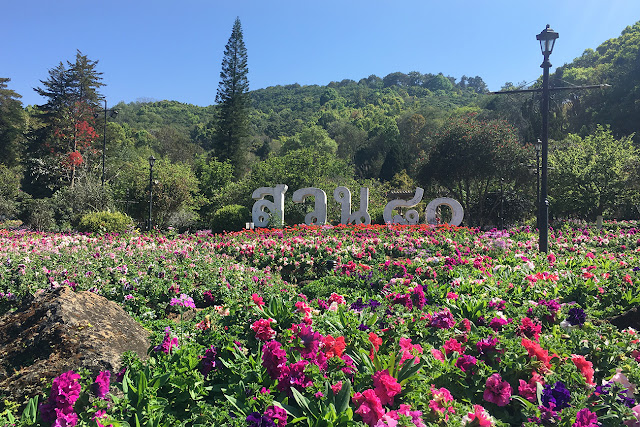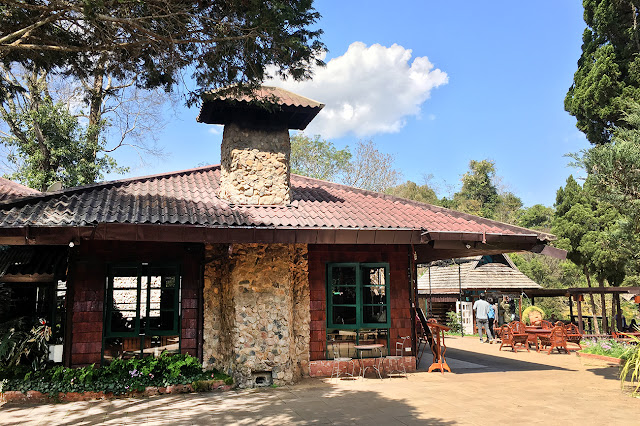Sitting in the middle of South East Asia, Thailand covers a vast area and is home to some of the most iconic species of the region. Despite the lack of any true endemics in Thailand, the country’s geographic location runs through some avifauna hotspot and has a bird list of well over 1,000 species, 200 species more than Malaysia! From the Himalayan species in the north to equatorial species in the south, birders will find a good number of highly sought after birds here, some more easily found here than elsewhere.
Northern Thailand sits just south of Myanmar and Laos, being at the foothills of the Himalayas, many species here are shared between Yunnan further north. Captain initiated this trip a few months back, I've been to a few other South East Asian countries but never to Thailand. I got in contact with local bird guide Atiwich Ball, hoping to sample some of the species found in this avian rich region. Our main targets were Giant Nuthatch, Himalayan Cutia and Hume’s Pheasant. Captain and I along with five other birders (Francis, Alfee & Hailey and Peter & Michelle Wong) met on the 16th of February for a direct flight to Chiang Mai.
Day 1 - Chiang Mai to Fang
It only took 3 hours to fly from Hong Kong to Chiang Mai, we arrived safely and met up with Ball at the arrival hall. We managed to fit everything into a single van. We stopped for lunch at a restaurant in suburban Chiang Mai, after our bellies were filled we were already hungry for birds and birded the restaurant’s proximity, here we found a few common species such as Purple Sunbird, Olive-backed Sunbird and Brown-throated Sunbird.
Purple Sunbird - male
Olive-backed Sunbird - male
Brown-throated Sunbird - female
Black Drongo and Brown Shrike were also added as well as common species such as Greater Coucal, Ashy Drongo, White-breasted Waterhen and Ashy Woodswallow to name a few. 24 species added onto our trip was not bad for a lunch break!
Black Drongo
Brown Shrike
Two hours on the road and we arrived at Fang, a large town that act as our base to birding location in the north. We stayed at a small hotel name Punn Punn Place, it was basic but quite comfortable, and this was to be our accommodation for the next six nights. Not many birds were found around the hotel, but a flock of Sooty-headed Bulbuls greeted us at the car park, we also added a pair of Common Tailorbirds and few flocks of fly-by Cattle Egrets returning to their roost somewhere nearby.
Punn Punn Place
Sooty-headed Bulbul
Common Tailorbird
After dinner we stocked up on some supplies at the nearby Tesco (never expected that in Thailand!) and called it a night. We were to meet at 5:30am the next morning.
Day 2 - Doi Angkhang
Everyone was up and ready by 5:30am, we stopped at a nearby convenient store to get some breakfast, sticky rice in bamboo stick was a nice way to start the day off. It took nearly 2 hours to get to our first birding spot at the Army Camp of Doi Angkhang, this is basically a stretch of road along a ridge that is quite birdy early morning. Ball told us this is probably the easiest place to see Giant Nuthatch.
Road outside Army Camp of Doi Angkhang.
It was indeed very birdy, we were immediately surrounded by birds when we arrived, a small flock of Buff-throated Warblers fed along the roadside, as were a pair of Grey Bush Chats. Brown-breasted Bulbuls showed briefly, while Flavescent Bulbuls danced around in the nearby bushes.
Buff-throated Warbler
Bush Grey Chat - male
Brown-breasted Bulbul
Flavescent Bulbul
Things improved as a flock of Black-backed Sibias and Rufous-backed Sibias arrived. With them came Long-tailed Minivets, Silver-eared Mesias, Blue-winged Minlas and Ashy Drongos.
Black-backed Sibia
Rufous-backed Sibia
Long-tailed Minivet - male
Long-tailed Minivet - female
Silver-eared Mesia
Blue-winged Minla
Ashy Drongo
On closer inspection we added some smaller birds, including a few Bar-winged Flycatcher-shrikes and a male Slaty-backed Flycatcher. A pair of Little Pied Flycatchers and Hume’s Warblers were spotted while we enjoyed our second breakfast...
Bar-winged Flycatcher-shrike - male
Slaty-backed Flycatcher - male
Little Pied Flycatcher - male
Hume's Leaf Warbler
One of the best species of the morning were three Spot-winged Grosbeaks which showed beautifully on a bare tree, with two males accompanying a female. Captain spotted a few Scarlet-faced Liocichlas, they however were too quick for anyone to get a good look.
Spot-winged Grosbeak - female
Spot-winged Grosbeak - male
An Eastern Buzzard drifted past under the clear blue sky, only to be followed shortly by a Shikra. Songs of Davison's Leaf Warblers filled the trees, but none were particularly friendly.
Eastern Buzzard
Shikra
Davisons's Leaf Warbler
Calls of the Giant Nuthatch taunted us throughout the morning, while views of the smaller Chestnut-vented Nuthatch gave false alarm a few times. A male Stripe-breasted Woodpeckers was seen at a distance, the female was however slightly more cooperative, allowing a closer look. Suddenly as if out of nowhere, a Giant Nuthatch came in together with the woodpeckers, it flew over our heads and gave fleeting views for everyone, not quite the view we hoped for but we were still happy to have seen one of our major targets on our first morning!
Giant Nuthatch habitat
Chestnut-vented Nuthatch
Stripe-breasted Woodpecker - male
Stripe-breasted Woodpecker - female
Doi Angkhang Royal Agricultural Station
Black-backed Sibia
Oriental White-eye
Mountain Bulbul
We walked around the main road and found a fruiting tree with yet another flock of Spot-winged Grosbeaks, they provided more excellent views. A blossoming cherry tree nearby also attracted a beautiful male Gould’s Sunbird.
White-winged Grosbeak - male
Gould's Sunbird - male
Scanning a very tall flowering Bombax tree was rewarded with a singing Blue-throated Barbet, a Stripe-breasted Woodpecker, Streaked Spiderhunter and best of all a pair of Maroon Orioles.
Blue-throated Barbet
Stripe-breasted Woodpecker - female
Streaked Spiderhunter
Maroon Oriole - male
Maroon Oriole - female
After a decent lunch in the park restaurant, Ball took us to a Black-breasted Thrush stakeout, where a flock of them can be found foraging behind the restaurant, looking for hand-outs by people. The thrushes were the only notable birds there, so we moved on to the upper gardens to look for other birds.
Lunch at the Royal Project Kitchen
Black-breasted Thrush - male
Black-breasted Thrush - female
Ball told us a few wintering Scaly Thrushes had been active in the cherry tree garden. It took us a while to locate one of them, but once located it was not shy, giving everyone a good look.
Scaly Thrush
The flowering garden was a great place to look for Sunbirds and White-eyes, here we saw both Black-throated and Gould’s Sunbirds in good numbers. Some of them were completely oblivious to passing tourists and allowed extremely close views. Both Chestnut-flanked and Oriental White-eyes were also active in the garden.
Gould's Sunbird - male
Black-throated Sunbird - male
Chestnut-flanked White-eye
Oriental White-eye
White-tailed Robin - male
Hill Blue Flycatcher - male
Rufous-bellied Niltava - female
We returned to the gardens once everyone got some good photos of the three species. There we waited for the Grosbeaks to come down to feed on the cherries. As we waited we saw Oriental Honey Buzzard and Crested Goshawk, while at least a pair of Scaly Thrush were found feeding on the ground. Mountain Bulbuls also frequented the garden.
Oriental Honey Buzzard
Crested Goshawk
Scaly Thrush
Mountain Bulbul
Things were a bit quiet so we walked back towards the Bombax tree hoping to find something new, but only yielded a Taiga Flycatcher and a male Stripe-breasted Woodpecker. A Velvet-fronted Nuthatch was also seen.
Taiga Flycatcher
Stripe-breasted Woodpecker - male
Velvet-fronted Nuthatch
We walked back over to the cherry garden and Ball made a gesture for us to hurry over, turns out the Grosbeaks had landed on a taller tree, making sure the garden is safe enough before coming down to feed.
Spot-winged Grosbeak - male
Spot-winged Grosbeak - female
We waited a little while until a few of them felt safe enough to drop down and feed on the cherries at eye-levels! They provided absolutely amazing views for the next 20 minutes or so, before all flying off into the distant together, ending our day on a perfect note. That night we celebrated with bottles of Chang beer and an early night, ready for an early start the next morning.
Spot-winged Grosbeak - male
Spot-winged Grosbeak - female
To be continued...


















































































No comments:
Post a Comment